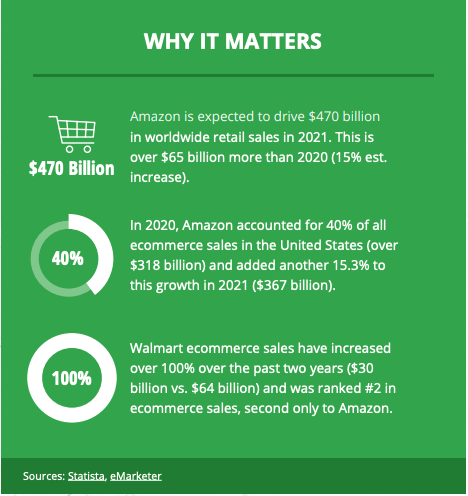
While, understandably, we did not see a repeat of the massive spike we experienced in 2020, our prediction that ecommerce activity would continue its upward trajectory came to fruition.
Beyond any additional fears surrounding the pandemic, a number of other factors help account for the continued preference for making purchases online.
These include product availability, alternative product adoption, and overall convenience—just to name a few.
This proclivity is setting brands up for another year of opportunity to take advantage of this continued consumer shift.
It’s time, once again, to move more commerce efforts into the digital ecosystem. Those who are accustomed to purchasing online will continue to do so, and those who have just begun adopting this practice are far more likely to continue using this resource now that they’ve had a taste.
Let’s take a look at how 2021 panned out for the ecommerce world and why we think that a greater leveraging of ecommerce marketplaces may be the profitable bet in 2022 and beyond.
The 2021 Holiday Numbers Are In…
It’s no surprise that when it comes to ecommerce purchasing, most brands are thinking about the biggest shopping season of the year—and for good reason.
Not only is the holiday season the greatest opportunity to close out the year on a high note (as the world is in “shopping mode”), but it can also be the perfect way to fill up the repeat purchasing pipeline for the year to come.
This is on top of the massive 44% jump in ecommerce purchasing we saw in 2020. However, this was the booming holiday shopping season, so we should take these numbers with a grain of salt.
We also saw that Cyber Monday scooped up around 17% of the holiday shopping take.
This may have been driven by reports of early shopping activity due to fear over shipping times and supply chain issues.
All in all, with nearly double-digit jumps in consumer spending, which crushed the average 4.4% holiday spending jumps from pre-pandemic years, the holidays seemed very happy indeed.
A Widening Ecommerce Reach
So, where are our savvy consumers spending their hard-earned cash online? Well, it will come as no surprise that Amazon has been the dominant destination for online shopping. Also in the top 5 spots were eBay, Walmart, Rakuten, and Etsy, all of which have seen additional attention and growth over the past couple of years.
As more SMBs move into the online space, it can seem daunting to compete with the likes of these ecommerce giants. But remember, each of these platforms are vessels you can use to expose your products to new customers. The cost and “red tape” may be higher, but the volume you can potentially move may make up for this.
Over 90% of customers online have made a purchase from a digital storefront, so there is really no reason to not have a presence online.
As an added benefit, your digital storefront allows you to keep your “doors” open 24/7—to anyone in the country (or the world).
The ecommerce website platforms driving the highest use and purchase activity are WooCommerce, Shopify, and, surprisingly enough, Wix.
However, if you want to give yourself the best of both worlds when it comes to design capabilities and ecommerce functionality, we suggest going with Shopify. It is highly flexible, can integrate with almost everything, and can scale easily with your business.
The Future Impact of Ecommerce
Since the early days of the pandemic, we have been saying we were going to see a more rapid shift to ecommerce purchasing—but not for the surface-level reasons you may be thinking.
While originally this move to online buying may have come from necessity, once consumers were exposed to the convenience and choices the online space had to offer them, many have decided to continue to stick with (or prefer) this mode of purchasing.
In short, the ecommerce shift that was already in motion simply got shifted into hyperdrive in very short order.
When we look at the longer-term impact of ecommerce, the opportunities we see get far more interesting. According to Statista, retail ecommerce in the US is projected to grow from nearly 469 billion in 2021 to over 500 billion in 2022, not to mention the projected growth in the years to come.
Data also shows that over 45% of SMBs still don’t have a website or digital commerce option, meaning that there is ample opportunity to go direct and expand your business research beyond your local market.
There is also the fact that some of the highest ROI (when it comes to driving ecommerce sales) will come from your first-party data, which your ecommerce site can help facilitate for you. With 60% of customers saying that they have made a purchase from a direct brand email, along with additional data showing that email accounts for upwards of 20% of total ecommerce transactions, not leveraging the online space is a missed opportunity.
Start Planning Now
Those who put it off now are destined to either tread water or potentially sink in the near future.
Consider the journey your customers are taking online, and start uncovering where your strengths, weaknesses, and opportunities are, so you can make this year your best ever. And if you need another set of eyes, that’s what we’re here for.
Our team of specialists can give you a complete analysis of your strategy, your website, or even your Amazon listings to help you get ahead.
Click here to shoot us an email, and we can pair you up with a strategist to specifically meet your needs. You can also send an email directly to Marketing@NationalPositions.com.
Cheers to an amazing start to 2022! Oh and dont forget to download you free copy of our eBook for 2022: Maximizing ROI and Supercharging Profits in the Digital World!